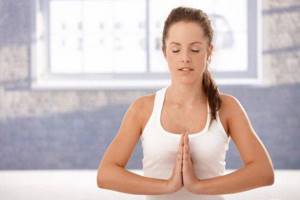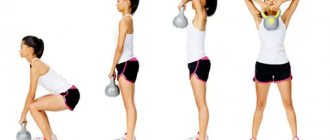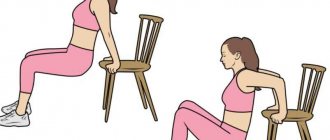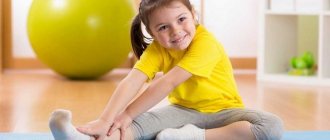Khadu gymnastics not only gets rid of extra pounds, it also rejuvenates the body and improves the health of the spine and joints. It suits absolutely everyone! Get 4 super-effective complexes and lose weight without leaving home!
Author: Kristina Lobanovskaya, doctor, practicing nutritionist Article updated: 11/10/2020
Ask a Question
Khadu is a universal health-improving gymnastics that is suitable for absolutely everyone, regardless of gender, age and health status. It has a diverse positive effect on the body, healing the entire body completely, but first of all it helps to get rid of problems with the spine and joints. Khadu gymnastics is easy to perform, does not require any exercise equipment or other equipment and can be performed in any convenient place.
The author of this system is Zviad Arabuli, who named it after his native village, famous for its long-livers. The basic principle of gymnastics was borrowed from the ancient practices of Hatha Yoga. It lies in the fact that training the opposite muscles ensures their development. An example of the effectiveness of such techniques can be the Shaolin monks, who did not use any exercise equipment, but their physical fitness is unparalleled. This is explained by the fact that the muscles themselves are the best tool for training the body. This discovery was the beginning of a new system for healing the body.
Hadou's philosophy
The ideological basis of Hadou gymnastics is the principle of harmony and building the body in accordance with the main rule of the entire universe. A harmonious healthy body is the goal of this technique. But no one had strived for harmony before.
A person is by nature endowed with a full set of muscles, although in ordinary life only a small part of it is used. Therefore, the huge energy potential remains unclaimed. In order not to disrupt the energy cycle in the body, it must be constantly used. To do this, it is necessary that the body gets tired and recovers, and all the muscles given by nature work. All muscles are equally important and they all need to be developed.
Muscle training in Hadou gymnastics is not considered as the development of purely physical energy. It is impossible to train the body without awareness and will - and this is within the control of a person: by training the body, he develops his will, and by strengthening his will, he develops the body even more.
According to the founder of the method, the main parts of the body are:
- the musculoskeletal system is the basis that creates movement;
- metabolism serving this basis;
- the nervous system that controls the first two systems.
This means that the metabolism and nervous system will never be in order if the musculoskeletal system is undeveloped or unhealthy: the stronger it is, the better the “servicing” systems work. Therefore, it is possible to improve metabolism or the functioning of the nervous system only through improving the musculoskeletal frame.
Old age in Hadou's philosophy is also considered as a severe degradation of the musculoskeletal system, entailing the destruction of all other systems. A harmoniously developed musculoskeletal system is the key to health and active longevity. Therefore, by restoring these foundations, Hadou gymnastics also fights the aging of the body.
How is such gymnastics useful?
What exactly are the benefits of simple short gymnastics for Had?
- First of all, regular exercise quickly improves your overall well-being. Blood flow accelerates and metabolism normalizes. Having become accustomed to the fact that half of the muscles in our body are constantly inactive, we do not notice the lethargy and fatigue accumulating in them - and we understand the difference only by comparing the sensations.
- Khada gymnastics cannot be considered a miraculous way to combat excess weight. However, the combination of exercises with a diet and a proper daily routine brings excellent results - but only a little time is spent.
- Muscles develop while remaining the same in volume. This will especially please women who are often simply afraid to take up dumbbells - excess muscle does not go well with a feminine appearance.
- A vigorous, well-developed body is a source of good health and positive mood. In addition, along with muscle development, general immunity is strengthened and skin condition improves.
Benefits and indications
This type of gymnastics has a number of advantages that set it apart from other similar techniques:
- saving time - to achieve positive results, it is enough to conduct 3 workouts every week lasting 1 hour without going to the gym;
- lack of additional techniques and auxiliary tools - Hadu is a completely independent and complete technique that does not require massage and other manual procedures, taking medications, or using sports equipment;
- safety - all Hadu gymnastics techniques are performed at a slow pace, eliminating physical overload, which allows gymnastics to be practiced even by people with disabilities or after suffering injuries;
- eliminating the causes of the disease - this healing technique involves working with all muscle groups - from the face to the toes, as well as working on the spine and joints, which improves blood supply and restores all tissues, including soft, bone, cartilage.
The effectiveness of Hadou gymnastics is achieved through tension of opposing muscles, that is, two muscle groups are involved in the process - those being contracted and those opposing them. The movements are performed slowly, but with increased tension, until fatigue is felt in the trained area.
A harmoniously developed body has always been considered a sign of beauty and health. From antiquity to the present day, people have been trying to achieve certain standards. But this approach is fundamentally wrong. Muscles should not form volumes, but create efforts. Therefore, harmonious proportions should be determined by strength capabilities, which should be the same in opposite muscle groups. Only by developing the body according to this principle can one achieve harmony and improve health.
Hadu is strength gymnastics of maximum efficiency, which develops strength, not muscle volume. The big advantage is that it uses muscles that are not normally trained (facial muscles, cervical muscles, extensors).
This technique is recommended for everyone who wants to heal and rejuvenate their body. It is also suitable for training in cases where you need to “pump up” or lose weight without the use of strength equipment and visits to the gym. The complex itself was developed on the basis of gymnastics, used to maintain the physical fitness of astronauts, submariners and other people forced to stay in a confined space for a long time. Some elements of gymnastics are suitable for restoring muscle tone after injury. Overall, Hadu is a healing practice that is suitable for everyone.
Basic principles
All exercises are performed in accordance with the following principles:
- movements are very slow;
- voltage – maximum;
- the result is complete fatigue of the loaded section.
Gymnastics is very intense due to strong muscle tension, which is slowly brought to the highest degree of fatigue. Therefore, the training is short (about 30 minutes), but most effective.
The main difference between Khadu and classical training is that during the exercise two muscles are tensed - the one being loaded and its antagonist. At the same time, they work in a static mode, which helps accelerate metabolic processes in tissues and the body as a whole.
In addition, great importance in Hadou gymnastics is attached to the restoration of the spine, which over the years becomes deformed, shortened and weakened. It returns the spine to its correct position and strengthens the muscles that support it.
Elderly people and those for whom any other stress is contraindicated can practice Khada. It is suitable even if you have diseases of the spine and joints.
In this case, the training must meet the following requirements:
- to be very heavy is a law of Nature: only those who undergo strict natural selection, the criterion of which will be Harmony, can remain young and healthy;
- be short - gymnastics should take only a small part of the energy, since it is unreasonable to use the full potential only to strengthen muscles;
- be performed without the use of any equipment - Nature does not provide that a person should improve with the help of devices, therefore it is more natural and rational to use only one’s own capabilities;
- develop muscles unevenly - with the same load, weak muscles will strengthen, and strong ones will become even stronger, which is not the goal of this technique.
This is exactly the kind of training that Hadou Gymnastics offers. It is simple and harmonious, since the idea was borrowed from Nature itself.
Hadoo exercises
Gymnastics consists of 40 different exercises, divided into groups:
- basic complex for every day;
- blitz complex for 18 minutes (morning exercises);
- rejuvenating complex for women after 40;
- exercise for face and eyes;
- complex for sedentary and others.
Usually they are performed separately, dividing 10 exercises, but if desired, you can use all 40 in one workout.
Basic complex
The basic Hadu gymnastics complex for every day includes exercises to strengthen the spine and improve posture.
Weightlifter's stance
Place your feet wider than your shoulders, perform a small squat, lower your shoulders and spread them, arch your back. Take a deep breath, spread your shoulders as far as possible, and arch your back even more. As you exhale slowly, slouch so that your shoulders hang on your neck, tense your abs, and tuck your tailbone inward. Repeat 10 times.
Fists to the ground
Repeat the previous exercise, but as you inhale, bend your arms with your palms up, pull your elbows back, trying to squeeze your shoulder blades together as much as possible. As you exhale, lower your arms, squeezing your fingers until they are bent. Look forward without leaning. Repeat 10 times.
Chest press
The starting position is similar to the previous exercises, but the arms bent at the elbows are raised up at shoulder level, as if holding an imaginary barbell with a wide grip. While inhaling, perform a chest press, arching your back, expanding your chest as much as possible. As you exhale, stretch forward, as if clinging to a high bar with your hands. Repeat 10 times.
Ring
Imagine a rubber ring in front of your face at arm's length. As you exhale, reach for it, turning your palms outward, arching your back so that the muscles between the shoulder blades stretch strongly. As you inhale, stretch the ring, as if trying to pull it towards yourself, expand your chest, bend over. Repeat 10 times.
Body-builder
Take a bodybuilder's pose, raising your arms, and take a deep breath. While exhaling slowly, take a step with your foot, lean forward, lower your arms, crossing them in front of you. Always look forward. Repeat 12 times.
Rack
Spread your legs wide, perform a shallow squat, bend forward, bend your lower back, stretch your arms forward at 90°. Imagine that your hands grabbed the two ends of the rope, while exhaling, pull them towards you, press them to your chest, raising your torso, but remaining in a half-squat. Repeat 10 times.
Pelvic rotation
Stand straight, legs apart, slightly bent. Smoothly rotate your pelvis in one direction, then in the other direction. Try to perform the rotations gracefully so that they resemble dance movements.
Abdominal breathing
Stand straight, slightly slouch, bend your knees, lower your arms along your body. Inhale through your stomach so that your chest remains motionless. When your stomach is as round as possible, you can exhale slowly, curling your lips into a tube. Repeat 20 times.
Abdominal retraction
Stand straight, with a short inhalation, draw in your stomach, sticking out your chest, bending at the lower back. Pull your shoulders back as much as possible. As you exhale, return to the starting position. Perform at an accelerated pace. Repeat 12 times.
Boxer
Stand up straight. As you inhale, spread your shoulders, move your arms back, throw back your head and bend at the lower back. Pull your chin and chest up, trying to “touch the sky.” A slight cough is possible from severe stretching of the trachea. As you exhale, slouch, press your chin to your chest, and cover your head with your arms bent at the elbows. If your chin touches your chest, lightly press the back of your head with your hands. The neck and arms should be in constant tension. Repeat 12 times.
Chinese bobblehead
Stand straight, spread your arms to the sides, raise them to shoulder level, move your elbows back a little. As you inhale, gently tilt your head back, lean forward, raising your shoulders. Tighten your neck muscles, try to reach the back of your head to your shoulder blades. A burning sensation and numbness should appear in the back of the head.
We look left and right
Stand up straight. Tighten your lower jaw, move it forward slightly without clenching your teeth. Slowly turn your head to the limit, first in one direction, then in the other direction. Breathing is voluntary. Repeat 20 times.
Birdie
Stand straight, spread your legs wide, spread your arms to the sides at shoulder level, and move your elbows back. As you inhale, raise your arms, and as you exit, lower them to shoulder level, trying to smoothly reproduce the flapping of the wings. Repeat 16 times.
Twist
Stand up straight. As you inhale, pull your shoulders back, expand your chest, press your chin as high as possible and do not lift it during the entire exercise. As you exhale, you need to fold around the peritoneum - move your shoulders forward, bring your arms together, connecting them with the backs of your hands, squat slightly, arch your back like a wheel. Pull your shoulders down and your elbows to the sides. Repeat 10 times.
Dinosaur
Spread your legs wide apart. As you inhale, bend your back and lean forward so that your stomach is between your knees. The head looks up, the back of the head stretches back so that the stretching of the back muscles is felt. As you exhale, straighten up, press your chin to your chest, and perform a twist as in the previous exercise. Do everything slowly and smoothly. Repeat 8 times.
Monkey gait
Place your feet slightly wider than your shoulders, bend your arms slightly, and move them back. Slowly, waddle from foot to foot, imitating the gait of a monkey. Don't slouch, don't lift your heels off the floor. When tilting the shoulder, stretch the edge towards the pelvis. Repeat 20 times.
Frog
Stand straight, spread your legs wide. Place your hands behind your back, imagining that they are holding a stick. As you inhale, raise this “stick” above your head, stretching your whole body upward, pulling your shoulders in, rising on your toes. As you exhale, slightly bend your knees, bend your lower back, lower the “stick” onto your shoulder blades, and try to bring them together. The “stick” is always behind the back, the hands are bent in the form of a hook, the arms do not relax. Repeat 12 times.
Bike
Sit on a chair, raise both legs, alternately bend and straighten them at the knees, imitating riding a bicycle. Turn the “pedals” slowly, with great effort, without rotating, but only pushing, raising your knees as high as possible. Repeat 20 times.
When performing each gymnastics exercise, Had needs the muscle tension to be maximum, almost to the limit. At first, some of them will be difficult to perform, but over time the body will get used to it.
Complex blitz for 18 minutes
This complex contains the basic principles of Hadou gymnastics, takes 18 minutes and can also be used as morning exercises. The exercises should be performed in the following order:
- Starting position – feet shoulder-width apart, back straight, arms hanging freely. Inhale through your nose while simultaneously doing a shallow squat, your arms are pulled back and tense, your stomach is pulled in. After this, straighten up, exhale through your mouth, relax your arms, bring them forward, and arch your back. Perform 2 times for 4 approaches.
- The position is the same, but when inhaling and performing a squat, the arms are bent at the elbows and pulled back. Then exhale through the mouth, return to the starting position with gradual straightening and rounding the back (slouching). Bring your hands together as before jumping into the water, palms down. The body and arms should be constantly tense. Do it 8 times.
- The position is the same, while inhaling, bend your elbows with your palms up, squat down and move your arms, without straightening them, back, as if holding a barbell. Straighten up, round your back, exhale through your mouth and stretch your arms forward. Do it 8 times.
- The position is the same, but the arms are straightened and the backs of the palms are brought together. Squat down, without opening your palms, pull them towards your head, then unclench them at your temples. Exhale, straighten up, round your back, bring your arms back to their original position. Do it 8 times.
- The position is the same, arms are straightened forward. As you inhale, take them back, lift them up, and do a shallow squat. As you exhale, hunch your back, extend your arms, clasp your palms, holding imaginary water. Perform 2 times for 4 approaches.
- Take a bodybuilder’s pose, strain your neck as much as possible, spread your arms to the sides and up. Exhale, relax. Perform 10 times.
- Stand straight, feet shoulder-width apart. Strain your neck, arms in front, elbows bent. Without removing the tension from your neck, turn it from side to side. Perform 4 times in 6 approaches.
- The position is the same, but the arms hang freely. As you inhale, make a strong, deep bend back; as you exhale, straighten up, slightly leaning forward and hunching. Perform 4 times in 6 approaches.
- Stand straight, press your chin to your shoulder. Rotate by rolling your head from shoulder to shoulder, moving your shoulders back, then in the opposite direction, bringing your shoulders forward. Perform 4 times in 4 trips.
- Stand straight, tense your neck and throat, throw your head back, spread your shoulders back. Then lower your chin, bringing your shoulders forward. Perform 16 times.
- Stand straight, while inhaling, draw in your lower abdomen, and while exhaling, relax. Perform 8 times at a slow pace, then start speeding up. Duration: 90 seconds at a fast pace.
- Stand straight, feet shoulder-width apart. Draw your stomach in tightly, raising your arms to the sides. Hold your breath, opening your chest. Hold this pose for 20 seconds, exhale, relax. Do it 3 times.
- Stand straight with your feet slightly wider than your shoulders. Pull your stomach in, tense your neck, lower your arms freely. Inhale, lean forward, arching your back at the same time as a deep squat. Straighten up, slouch heavily, lowering your head and exhaling air through your mouth. Perform 20 times.
- Repeat the previous exercise, but during the squat, spread your arms to the sides and raise them slightly up, and cross them over your chest as you exhale. Perform 10 times.
- Stand straight, pull in your stomach, spread your arms bent at the elbows to the sides at chest level. With tension, bend to one side, trying to reach the knee, then to the other. Perform 16 times.
- Stand straight with your feet slightly wider than your shoulders. Raise your arms slightly apart with your wrists bent, palms down. Inhale, do a squat, bend your elbows and place them behind your back at waist level. Exhale. Perform 10 times.
- Standing on one leg, take the other back, bend the knee with tension, not allowing it to move forward. Perform 8 times in 3 approaches on each leg.
- Perform a wide squat, fully resting on your foot. Arms extended forward with elbows pressed to the inner surface of the knees. As you inhale, hunch your back, and as you exhale, straighten your back. Perform 16 times.
- Finally, stretching. Stand straight, standing at attention. Raise your hands, inhale deeply through your nose. As you exhale, bend over, touching your palms to your toes. Do it 4 times. Relax.
During exercises, it is necessary to control your breathing. Inhalation and exhalation should be deep enough.
Rejuvenating complex
This technique is intended for women after 40 years of age, when the active aging process begins. Khadu gymnastics helps maintain health and youth due to beneficial effects on the body:
- strengthening muscle tone;
- normalization of the nervous, endocrine and digestive systems;
- activation of metabolism;
- reducing body fat;
- weight loss and weight loss;
- prevention of osteoporosis.
Regular gymnastics can strengthen the musculoskeletal system, improve vision and brain activity.
In addition, there is a separate anti-aging complex for the face and eyes, which can eliminate the external manifestations that invariably appear with age. When performing these techniques, blood flow to the muscles increases, with which more useful elements are supplied and harmful substances are eliminated.
For face
Facial muscles are used unevenly and very little, which leads to the premature appearance of wrinkles and sagging. To prevent or correct this, it is necessary to train certain muscle groups. The essence of Hadou gymnastics for the face comes down to the fact that first the muscles are stretched as much as possible and then compressed.
The training is performed according to the following scheme:
- Stretching - the face stretches out, as if expressing excessive surprise, while the mouth opens and a long “O” sound is pronounced without opening the lips. The entire lower part of the face, starting from the upper lip, is pulled downwards as much as possible, the forehead is pulled up.
- Shrinking – the face is strongly compressed, including the eyes, eyebrows, cheeks, and forehead. The teeth should not close together.
The exercise can be performed at any pace. Repeat at least 60 times until the muscles become numb.
For eyes
This Khadu gymnastics complex is recommended to be performed immediately after facial exercises, which ensure increased blood flow. This is what needs to be directed towards the eyes.
Exercise No. 1
It is performed with eyes closed in this order:
- eye movements to the sides - 60 times;
- eye movements up and down – 60 times;
- movements diagonally from bottom right to top left – 60 times;
- movements diagonally on the contrary - 60 times;
- rotational movements clockwise – 60 times;
- rotational movements counterclockwise – 60 times.
Exercise No. 2
Eye focus training performed:
- Place your index finger at the level of the bridge of your nose;
- Focus your gaze on it and slowly bring it closer to your eyes.
When the pattern of lines on the pad begins to blur, this will be the border. It needs to be expanded by holding focus and moving your finger closer and farther away.
These simple exercises will not only help strengthen the eye muscles and eliminate wrinkles, but also normalize vision.
A feature of Hadou gymnastics is the development of “lazy” muscles that cannot be affected by regular exercises. During such training, the activity of all parts of the brain is activated and blood circulation is stimulated, which helps to tighten the facial contour and eliminate sagging skin without expensive cosmetic procedures.
Complex for sedentary
Among the exercises of the unique Khadu method there is a special complex for people who cannot exercise while standing, but only while sitting. It is as effective as all the others and helps to maximize the health of the body.
- Take a deep, noisy breath in through your nose, exhale through your mouth, opening your chest wide.
- Continuing to breathe in the same way, spread your tense arms wide to the sides and back - as you inhale, bring them together in front of your chest - as you exhale.
- Continuing to perform at the same pace, raise your tense arms up as you inhale, and as you exhale, cross them over your chest and round your back, pushing your shoulders forward.
- Breathing at the same pace, bend your arms at the elbows, tilt your hands with your palms down. Move your arms up and back without straightening - while inhaling, stretch them forward with a slight tilt - as you exhale.
- Stretch your arms forward, bringing the backs of your hands together. As you inhale, pull your elbows back without straightening them, so that your bent palms touch your temples. As you exhale, return to the starting position.
- Press your palms to your knees spread out to the sides. Bend your torso to the sides, lowering your shoulder to your pelvis as much as possible with each bend.
- Repeat the same exercise, but with your arms lowered along your body.
- Repeat the exercise again, but the bends should be double.
- "7-9-11." Take as deep a breath as possible, raising your arms above your head. Then seven exhalations alternately - one when crossing your arms on your chest, the second when raising them above your head, the third again when crossing, etc. Then another deep breath and 9 exhalations according to the same pattern. After this, another inhalation and 11 similar exhalations. Finally, stretch by taking a deep breath and raising your arms and opening your chest, exhale completely, lowering your arms.
- Lower your arms along your body. Perform circular movements with your shoulders, raising them as high as possible. First 16 times forward, then 16 times back. The thoracic spine should warm up well.
- Spread your arms to the sides, without bending your elbows, make rotational movements with your hands, trying to turn the back of your elbow and shoulder forward and then back. First, alternately with each hand 16 times, then 16 times with both hands at once.
- "Bird." In the starting position, the arms spread to the sides should be bent at the elbows and the hands should be lowered down, the fingers should be spread out and tense. Raise your elbows and shoulders up, imitating the flapping of wings.
- Hands on knees. Raise your chest sharply, while strongly drawing in your stomach. Breathing is not synchronized with work; inhalation and exhalation must be voluntary. First at a slow pace, then bring it to the fastest possible pace.
- Tighten your shoulder girdle, slightly raise your arms bent at the elbows in front of you. With effort, lower your chin to one shoulder, then to the other. The hands are tense, as if they were holding a very heavy horseshoe.
- Bring your shoulders forward, lowering your chin to your chest, then spread your shoulders back and throw your head back. Perform with tension, but at an intense pace.
- Turn your chin towards one shoulder, pull your head back with tension and gently roll, lifting your chin high so that it touches the other shoulder. Then do it in the opposite direction.
- As you inhale, raise your arms spread to the sides to shoulder level, while throwing your head back. Without lowering your arms, tilt your head forward, touching your chin to your chest. Repeat at an intense pace.
- The neck is tense, the hands on the knees are also tense. Take a deep breath, head back, arms spread down and to the sides. Exhale deeply, head leans forward, arms bend at the elbows, hands are placed behind the ears, closer to the back of the head, covering the head.
- Extend your arms forward, palms up. With an effort, bend them at the elbows, bring your hands to your shoulders, clenching them into fists.
- Do the same thing, but with your arms spread to the sides.
- Repeat the previous exercise, bending your arms alternately.
- Extend your arms to your sides, palms down. For 4 counts, place them behind your head, slowly turning your palms up. Lower your arms for 4 counts, slowly turning your palms down.
- Spread your arms to your sides, slightly up and back. Palms face up. Raise your palms up, bending your elbows 45°.
- Repeat the same exercise, but with your hands bent and down.
- Extend your arms in front of you, spread your fingers, as if they are holding a small ball. Make rotational movements - first clockwise, then in the opposite direction.
- Stretch your arms forward, raise your palms perpendicularly, then forcefully lower them down.
- Repeat the same exercise, but in a different plane - as if squeezing out a wet towel, holding it vertically.
- Stretch your arms forward, raise your palms perpendicularly, bend the phalanges of your fingers, then straighten them (like a cat scratching). Perform at a fast pace.
- Then turn your palms with the inside up and fold them inward one by one: first 4 fingers, then the thumb, then 4 again and so on.
- At the end of the complex - relaxation. Take a deep breath, gently raise your arms in front of you and up. Exhale - slowly lower, spreading your fingers and raising them up, as if stroking the invisible wall in front of you.
All exercises must be performed within 1 minute. The voltage should be maximum.
To prevent overloads, the following requirements must be met:
- do not rush and do not force the load, since the effectiveness of training depends on regularity;
- immediately stop exercising if weakness or dizziness appears, rest and you can continue training;
- At the initial stage, take short breaks between exercises; in the future, you can perform the complex without a break.
There are quite a lot of exercises for sedentary exercises in Hadu gymnastics. Among them there are those that were invented specifically to prevent getting used to a monotonous load. To perform it correctly, you need to feel what you have to do, since such actions are not typical of human behavior. Therefore, it is necessary to teach the body to resist itself.
Features of gymnastics
What are the main advantages and distinctive features of Hadou gymnastics that distinguish it from a number of other complexes?

- Firstly, it suits absolutely everyone. Whatever your level of physical fitness, the Hadu complex completely eliminates stretching or other damage to muscles that are unaccustomed to the load.
- Secondly, Hadu will save your valuable time. Basic exercises take about half an hour to forty minutes; there is also a blitz complex for only 18 minutes. On the busiest day, you can easily find a “window” for simple and quite exciting exercises. By the way, due to the short duration of the classes, they do not have time to get bored - therefore, there is much less temptation to be lazy and then give up the exercises altogether.
- Thirdly, you don’t have to worry about special equipment or expensive fitness memberships. Khadu exercises use exclusively the resources of your own body. However, there are many detailed videos of performing exercises - after watching, you will definitely perform them absolutely correctly.
By the way, if you are interested in such rejuvenation techniques, we recommend reading the article: Tibetan hormonal gymnastics.
It’s not for nothing that Hadou’s gymnastics are called “unique.” We are accustomed to the fact that any training complex that fully develops all muscle groups involves working with weights - dumbbells, exercise machines, barbells, etc.

But the gymnastics in question is based on something completely different - in all four exercises of the basic complex, you only imitate the movements of athletes or animals, tensing the corresponding muscles. Maximum effort here gives the same effect as in sports training - those muscles that you didn’t know existed begin to work. However, since the workout takes place without the use of additional weights, the body receives exactly the load for which it is truly ready.
Benefits for weight loss
Khadu gymnastics has a positive effect not only on tissues, but also on many processes occurring in the body, forcing it to work more intensively. This results in a faster metabolism and burns a lot of energy, which is required to perform specific movements. In addition, oxygen, supplied with increased blood flow in increased quantities, promotes the rapid breakdown of fat cells and activation of metabolism. Strenuous workouts themselves burn a lot of calories, which also promotes healthy weight loss.
The presence of all these factors allows us to give an affirmative answer to the question of whether it is possible to lose weight by exercising according to this system. Khadu gymnastics really provides fairly fast and stable weight loss.
Working to restore the spine, which becomes deformed with age, a special set of exercises allows it to return to a healthy position. At the same time, the stomach is tightened, the size of the chin is reduced, and the person becomes taller and slimmer.
Building a harmonious body with the help of Hadou gymnastics is quite simple. When performing movements with maximum tension, subconscious control is activated. The more muscles are in a simultaneously tense state, the greater their number is controlled by the subconscious, which itself determines the harmonious proportions of all muscles. By regularly practicing only this method, without resorting to any other activities, you can create a muscle corset sufficient to maintain health and youth. The built body may not correspond somewhat to generally accepted standards, but it will be the way it should be from Nature - harmonious and healthy.
Why is Khadu gymnastics called unique?
Now imagine. You are doing exercises. You already take better care of your body than 90% of people. Now you need to get your child to do exercises. Of course, you won’t talk about the fact that it’s terribly good for your health. In childhood, no attention is usually paid to health. But if you say that your daughter, say, will lose weight and be better than her classmate, she will probably think about it. It’s the same with Hadou gymnastics. If you call your brainchild, for example, “Health training without equipment,” few people will be flattered. But the exotic, incomprehensible word, and the book’s subtitle mentioning “rejuvenation” and “uniqueness”? This is great for attracting attention.
So what kind of “rejuvenation” does Z. Arabuli promise us? In reality, we cannot reverse the aging process. We are wearing out. And no matter what we do there, whether it’s strength training, yoga, or gymnastics, it’s inevitable. However, exercise tends to make us feel better. But, as some coaches sadly joke, exactly to the extent to which they do not worsen it.
So why do most people struggle with regular strength training? But it’s simply quite traumatic and requires skills. And if a person by the age of 30 already has a couple of hernias and arthrosis, he will most likely begin to suffer physically much earlier than he receives the first results.
Khadu's gymnastics is somewhat reminiscent of such a phenomenon as Primal Fitness. Only you will not have to imitate the behavior of wild animals and the flow of water, as in this fashionable lesson, but the movements of athletes, animals again, and simply popular motor patterns. You will simulate without any equipment. Which suggests that you have to be completely untrained in order to harm yourself with such exercises.
We are used to associating deterioration in well-being with “aging,” and improvement with “rejuvenation.” And yes, if we start at least some systematic physical training, we will feel better.
Objectively, Hadu gymnastics can:
- increase muscle tone. This is a rather pleasant thing, especially if before gymnastics the muscles were almost inactive. It immediately affects not only your appearance, but also your well-being. The muscles begin to cope better with the task of supporting the body in space. This alone can relieve annoying back or neck pain;
- improve appearance again by increasing muscle tone;
- increase calorie consumption;
- improve blood circulation.
All this is wonderful, some will say, but what about the focus on weight loss and rejuvenation. So, it is precisely these effects that we take for rejuvenation in the end.
The movements themselves either copy exercises from strength sports, or come from yoga and Pilates. The basis of Khadu's philosophy is a holistic approach to human health and its improvement through physical exercise.
Reviews and results of losing weight
Marina, 34 years old, Irkutsk
I read about the Zviad Arabuli complex by accident. Only the basic complex of Hadou gymnastics was described there. It seemed very simple to me, so I decided to practice. But from the first day I realized that the technique was fundamentally different from all the workouts I knew - aerobic, strength, stretching. Moreover, doing gymnastics turned out to be not so easy. Having completed a completely small complex of several movements, I was quite tired, which was very noticeable in my muscle tension. For variety, I sometimes began to replace my workouts with these activities. Then I became interested and found a complete list of exercises. There are about 40 of them. Somehow I wanted to try them all at once, but I couldn’t handle more than 20 - it was very difficult and time-consuming. Then I realized that I needed to separate them and not do them in a row, but change different complexes. In general, now I’m so used to it that I only train according to Had. Moreover, there are many videos that make it even easier to practice. I have lost weight, my body has become toned, and I look great.
Violetta, 23 years old, Moscow
This technique changed my life. In just 2 months of regular training, I achieved amazing results. I started doing Hadu gymnastics to lose weight, but managed to get rid of lower back pain and constant migraines. At the same time, the weight decreased slightly, but the volume decreased, the body became toned and sculpted.
Svetlana, 58 years old, Vologda
I am an active person, but for health reasons dynamic training is not suitable for me. After retirement, I try to lead a healthy lifestyle and move more. I started looking for something suitable for classes and found out about Hadoo. I’ve been doing it for almost a year now, and not only I, but all my loved ones have noticed results. The exercise for the face and eyes is especially impressive - my face has tightened up very well, I look 10 years younger in appearance, and my health has improved significantly. I didn’t intend to lose weight, but the weight is slowly coming off. This gymnastics gave me back my youth!











